How to Setup an AquaCorals Reef Tank  Tank Selection
Tank Selection
 Tank Selection
Tank Selection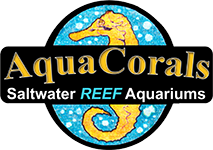
AquaCorals Reef System "Setup Recipe"
How & Why It Works
Tank Selection
The most important decision in this hobby you'll make! This is "Ocean Gardening" folks! This is NOT about how many gallons but rather, how much space will a tank give us for our "ocean garden"!
Pictured below is my 220g #2 - pic taken 11/2011.
I highly recommend a 75g MIN! BIGGER is better! Choose as large a tank as:
a. Your space will allow: Consider first how long a tank (L) your space can accommodate then how deep front to back (W) then... the taller the better (H)! = L x W x H
b. Your pocketbook can afford!
Keep in mind that:
a. Fish swim side to side more than up & down. Longer tanks will give your fish more room to swim even as they get larger! Seahorses need a taller tank vs width.
b. Your livestock is going to GROW! Your tank is prime real estate folks! You're going to want one of everything you see! The bigger the tank, the less limited you are to what you can have in it!
c. The larger the floor of the tank front to back the easier it is to stack & ramp your rocks front to back to create shelving space for corals. I do NOT recommend using a 55g tank! Do a 75g minimum! Also understand that the larger depth (front to back) of a 75g will give you more room in the stand for a proper sump setup. Again, I can't stress this enough ... 75g MIN.
BIGGER is always better! Don't be afraid of doing a larger tank! They're easier!!
d. If down the road you decide to upgrade to a larger tank, much of your smaller tank equipment will not satisfy the needs of the larger tank. Be smart & go with the largest tank you can the first time!
Example:
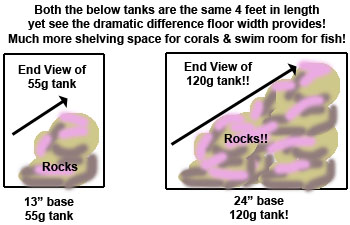
I DO NOT recommend Reef Ready tanks!
Predrilled or "Reef Ready"
Pictured below an All Glass overflow/return unit.
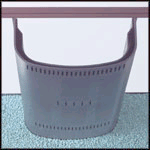

Permanent placement, low GPH, restricts internal water flow, restricts return placement & takes up valuable tank space
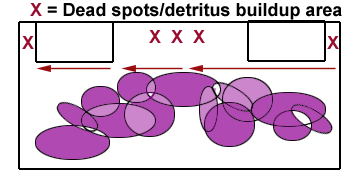
The diagram above is looking from the tank top down. The red arrows indicate water flow. Using All Glass as an example I found that the vast majority of their Predrilled tanks were WAY under the recommended minimum 10x GPH, allowing only 600 GPH maximum per overflow. Outflow & return placement is permanent and take up valuable tank space completely from tank top to bottom allowing for flow "dead spots". It is critical in this hobby to have outflow & return placement flexibility as successful tanks have corals that grow & flow needs to be adjusted at times to accommodate tank changes. These built-ins take up valuable inside floor space as noted by the red arrows in the diagram.
Lastly, the holes/slits accommodating overflow are very small & are easily clogged by coraline & detritus.
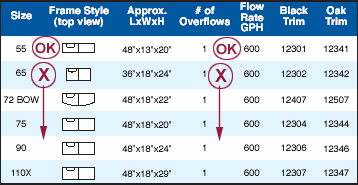
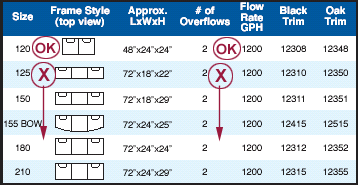
B: Drilled Tanks:
A better option than Predrilled but again, no placement flexibility, outflow placement is permanent & GPH is final once up & running. Also, water levels tend to be lower than other options as the water will spill out at the base of the hole.
Pros: Will always outflow as long as intake screens are clear. Do not take up valuable tank space nor restrict internal water flow. Returns can be placed as desired & somewhat flexible.
C. Overflow Box Sets - Simply The Best!
I recommend using them on tanks 30g & bigger. These provide the highest GPH per overflow without sacrificing water your level. Does not take up valuable tank space nor create dead spots. These units can be placed anywhere on your tank rim allowing complete outflow & return flexibility. Not a permanent fixture so can be used on tank upgrades etc.
Con of the Overflow Box Sets:
Air getting trapped in the top of the "U" tube & eventually breaking the siphon if left unattended.
Why does this happen? Our fault! Not enough water flow running through the "U" tube to keep air bubbles from getting trapped. When water flows through the "U" tube fast enough the sheer velocity of the flow will ZIP any bubbles completely through the unit. Run too little water through & bubbles can start to collect. Let me be clear here ... it takes an extremely slow flow to collect enough bubbles to break the "U" tube's siphon! If this happens, I dare say you are running too few GPH's in your tank to begin with or your pump is failing & isn't putting out the GPH it used to! In any event, you can see well in advance if air is starting to build up at the top of the "U" tube & remedy it before it becomes an issue. These units have been running my facility over 25 years without any trouble!
If you have questions or comments regarding this topic feel free to e-mail me.